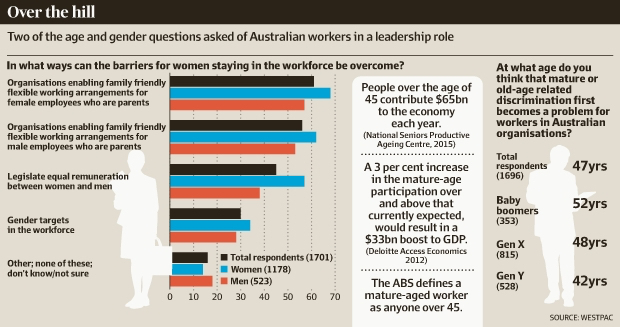According to studies since 2012, Australians over 45, who are considered by the Australian Bureau of Statistics as “mature aged workers”, contribute $65 billion to the economy annually.
So, with the mature age workforce such a benefit to the economy, why is there this perception that there is ageism in the workplace?
According to an article in the Australian Financial Review on 10th July 2015, the Westpac Women of Influence Report questioned nearly 1200 women and more than 500 men, earning over $85,000 a year and in senior leadership positions with responsibility for business performance or managing a team.
What they found was, older workers are thought to be more expensive to retain than hiring young people, and have outdated skills. However, nine out of the 10 people surveyed said older workers are underused, and that workplace diversity, which includes diversity of age, gender and cultural backgrounds, is good for business. In fact, a 3 per cent increase in mature-aged participation above what is now expected, would add $33 billion to the GDP.
So it makes perfect sense to remove the stigma that ‘mature age workers’ are stuck in their ways and behind on new methodology and technology and appreciate the benefits that come with experience, extensive knowledge and maturity.
For the mature age worker, it is their responsibility to maintain an open, positive and adaptable outlook, to be willing to learn, to be willing to adapt to changing circumstances and to maintain health and vitality during what, I believe, is the perfect time for professional and personal growth.
For those who are struggling with securing another role due to what they perceive is agism, here are some actions points that will help you to progress in the job search:
STEP 1: Reset your mindset
Maintain your confidence (you are still the same competent and capable professional you were at the beginning of this process.) Be fearless and know the value you have to offer employers – an amazing resume isn’t much use in the hands of a depressed candidate
STEP 2: Identify your goals and values
Create clear and concise career goals that align with your values. Be sure you know what you want so you can focus your efforts in the right places.
STEP 3: Identify and nurture your referees
Identify those who will be strong referees for you. Choose previous managers, co-workers, customers or vendors who know you in a professional capacity and think you are GREAT! Let them know your progress so you can prepare them when a reference check is imminent.
STEP 4: Create your action plan
It’s much easier to get to your destination if you have a roadmap. Let your action plan guide you with the tasks you need to complete on a daily, weekly and monthly basis. Set your own KPI’s (e.g. How many calls to your network will you make each day to set up how many meetings each week? How many hours will you spend each day researching companies, contacting recruitment agents, making applications, etc?) Having set targets to reach each day gives you regular small ‘wins’, ensures a sense of accomplishment and gets you closer to securing that interview.
STEP 5: Identify whom you know in your target market
This process should primarily be a people search, not a job search. People are the ones who make the hiring decisions. Online Job Boards are part of the process however your network will point you in the right direction. The right people can recommend you to those who are decision makers in your target market. Use LinkedIn to find out who can link you to people who can provide information, advice, guidance and, if you play your cards right, referrals to those who can get you in front of people who, in turn, can get you closer to the decision makers. (It’s a step-by-step process, sometimes it’s one step forward, one step back, so learn to dance in the moment!)
STEP 6: Identify your economic value to an organization
Identify your economic value and the organisational worth you bring to the companies in your target market. What will resonate best with the hiring manager? Research the challenges the department, the team or the manager is experiencing – you can use this information in your applications to stand out from other candidates.
STEP 7: Prepare your written and verbal introduction
Make sure you know what you want to get across in your career summary in your resume, in the opening paragraphs of your cover letter and when meeting with your network. What are you going to tell people about yourself? What is most relevant? Here’s a guide to your introduction if you get stuck.
STEP 8: Tailor your application
Create a powerful cover letter and resume; make them high-impact documents that communicate your ability to produce results. Provide proven examples of success in areas that are relevant to the role. If you need help with this, click here. Pick up the phone first when responding to an advertised position. By speaking with the advertiser you give yourself a chance to market yourself even before submitting the application. By asking for more information you may gain valuable insights so you can tailor your cover letter and resume accordingly.
STEP 9: Practice self-care
Take good care of yourself. Create a routine that feels good, take time every day to release tension – exercise, meditate, prepare nutritious, regular meals, get enough sleep. Schedule some time to meet up with your friends and allow yourself time to relax. When you get called in for an interview, you want to be well prepared and confident, not frazzled and exhausted.
STEP 10: Reassess every 2 weeks
Identify the strategies in your action plan (networking, working with recruiters, online applications and target marketing) that work for you and reassess what is not working. Focus on what yields the best results for you while keeping in mind that the majority of your time expanding your network in your target area.
Jane Jackson is a Career Management Coach and Author of #1 Amazon Australia (Careers) Bestseller, Navigating Career Crossroads. Click here for the paperback version or here for the eBook.
Listen to Jane’s career podcasts on iTunes: Jane Jackson Careers
To book in for a chat about changing career direction with Jane, click here



